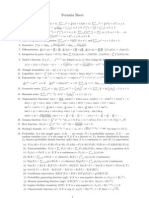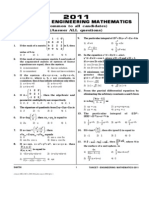A Formula
Uploaded by
Umesh Rao H NA Formula
Uploaded by
Umesh Rao H NFormulas (to dierential equations) Math. A3, Midterm Test I.
sin2 x + cos2 x = 1 sin(x y) = sin x cos y cos x sin y tan(x y) =
tan xtan y 1tan xtan y
dierentiation rules: (cu) = cu
(c is constant)
cos(x y) = cos x cos y sin x sin y
(u + v) = u + v
(uv) = u v + uv
u = u vuv v v2 df dg d dx f (g(x)) = dg dx
sin 2x = 2 sin x cos x tan 2x = sin x =
2
cos 2x = cos2 x sin2 x
2 tan x 1tan2 x 1cos 2x , 2
integration rules: cos x =
2 1+cos 2x 2
cf dx = c
f dx f dx +
1 a F (ax
(c is constant) g dx + b) + c,
sin x + sin y = 2 sin x+y cos xy 2 2 sin x sin y = 2 cos x+y sin xy 2 2 cos x + cos y = 2 cos x+y cos xy 2 2 xy x+y cos x cos y = 2 sin 2 sin 2 1 sin x cos y = 2 [sin(x + y) + sin(x y)] 1 cos x cos y = 2 [cos(x + y) + cos(x y)] 1 sin x sin y = 2 [cos(x + y) cos(x y)] x x x x cosh x = e +e sinh x = e e , 2 2 2 2 cosh x sinh x = 1 sinh 2x = 2 sinh x cosh x cosh 2x = cosh2 x + sinh2 x cosh2 x =
cosh 2x+1 , 2
(f + g) dx =
f (ax + b) dx =
where F is antiderivative of f f (g(x))g (x) dx = F (g(x)) + c, where F is antiderivative of f f f dx =
f f f +1 +1
uv dx = uv R(e ) R( ax + b)
x
dx = ln |f | + c
+ c, if = 1 u v dx ex = t ax + b = t
ax+b cx+d
notable substitutions:
sinh2 x =
cosh 2x1 2
ax+b cx+d
=t
derivatives: (sinh x) = cosh x (cosh x) = sinh x (loga x)
x 1 = x ln a 1
R(sin x, cos x) R(x, a2 x2 ) R(x, a2 + x2 ) R(x, x2 a2 ) x dx =
+1
sin x, cos x, tan x, tan x = t 2 x = a sin t, x = a cos t x = a sinh t x = a cosh t antiderivatives: ( = 1)
(x ) = x (e ) = e
x
(ax ) = ax ln(a) (sin x) = cos x
1 cos2 x 1 (cot x) = sin2 x 1 (ln x) = x 1 (arc sin x) = 1x2 1 (arc tan x) = 1+x2 1 (ar sinh x) = 1+x2 (ar cosh x) = x1 1 2 1 (ar tanh x) = 1x2 1 (ar coth x) = 1x2 1 (arc cos x) = 1x2 1 (arc cot x) = 1+x2
x +1 + c 1 ax e dx = a eax + c ax ax dx = ln a + c
cos x dx = sin x + c sin x dx = cos x + c
1 cos2 x dx = tan x + c 1 sin2 x dx = cot x + c 1 x dx = ln |x| + c dx = arc sin x + c a a2 x2 dx 1 = a arc tan x + c x2 +a2 a x dx = ar sinh a + c x2 +a2 dx = ar cosh x + c a x2 a2 x dx 1 2 x2 = a ar tanh a + c, a dx x 1 a2 x2 = a ar coth a + c,
(cos x) = sin x (tan x) =
if if
x a x a
<1 >1
tan x dx = ln | cos x| + c cot x dx = ln | sin x| + c
1. eit = cos t + i sin t, 2. ay + by + cy = 0 its characteristic equation: ar2 + br + c = 0. 3. Method of Undetermined Coecients: If in the equation ay + by + cy = g(t), the right-hand side function g(t) has the form g(t) = eut (An (t) cos(vt) + Bm (t) sin(vt)) , where An (t), Bm (t) are polynomials of degree n and m respectively, then the particular solution of the inhomogeneous equation has the form: yi,p = ts eut (Pk (t) cos(vt) + Qk (t) sin(vt)) , where s is the multiplicity of the root u + i v among the roots of the characteristic equation; further, Pk (t) and Qk (t) are polynomials of degree k = max(n, m). 4. Variation of Parameters Method: Consider the inhomogeneous d.e. y + p(t)y + q(t)y = g(t) tI a = 0 s t I e (a = 0) t R.
and its homogeneous part Y + p(t)Y + q(t)Y = 0. If the y1 , y2 pair is a fundamental solution of the homogeneous d.e., then a particular solution of the inhomogeneous equation is looked for in the form yi,p = C1 (t) y1 (t) + C2 (t) y2 (t), where for the derivatives of the unknown functions C1 (t), C2 (t) the following system of equations holds: C1 (t)y1 (t) + C2 (t)y2 (t) = 0
C1 (t)y1 (t) + C2 (t)y2 (t) = g(t)
5. Special second order d.e.s: If y is missing, then substitute p(x) := y (x). If x is missing, then substitute q(y) := y 6. The rst order d.e. M (x, y)dx + N (x, y)dy = 0 is exact, if M N = . y x To solve the d.e., a function F : R2 R has to be found such that gradF = (M, N ). Then the solution of the d.e. is: F (x, y) = Const.
You might also like
- X X X X Ecx Ecx: Tan - Sec Sec Cot - Cos CosNo ratings yetX X X X Ecx Ecx: Tan - Sec Sec Cot - Cos Cos4 pages
- Formula Paper For Calculus120 and Pre Calculus BNo ratings yetFormula Paper For Calculus120 and Pre Calculus B12 pages
- Notas Matematicas para Electronica de PotenciaNo ratings yetNotas Matematicas para Electronica de Potencia10 pages
- Theoretical Computer Science Cheat SheetNo ratings yetTheoretical Computer Science Cheat Sheet10 pages
- Capitolul I INTEGRALE (Recapitulareliceu) : Funcţii Elementare Funcţii Compuse 1) 2) 3) 4) 5)No ratings yetCapitolul I INTEGRALE (Recapitulareliceu) : Funcţii Elementare Funcţii Compuse 1) 2) 3) 4) 5)49 pages
- Multivariable Calculus, 2007-03-15. Per-Sverre Svendsen, Tel.035 - 167 615/0709 - 398 526No ratings yetMultivariable Calculus, 2007-03-15. Per-Sverre Svendsen, Tel.035 - 167 615/0709 - 398 5265 pages
- Integration Formulas: 1. Common IntegralsNo ratings yetIntegration Formulas: 1. Common Integrals10 pages
- De Moiver's Theorem (Trigonometry) Mathematics Question BankFrom EverandDe Moiver's Theorem (Trigonometry) Mathematics Question BankNo ratings yet
- Trigonometric Ratios to Transformations (Trigonometry) Mathematics E-Book For Public ExamsFrom EverandTrigonometric Ratios to Transformations (Trigonometry) Mathematics E-Book For Public Exams5/5 (1)
- Analytic Geometry: Graphic Solutions Using Matlab LanguageFrom EverandAnalytic Geometry: Graphic Solutions Using Matlab LanguageNo ratings yet
- Mathematics 1St First Order Linear Differential Equations 2Nd Second Order Linear Differential Equations Laplace Fourier Bessel MathematicsFrom EverandMathematics 1St First Order Linear Differential Equations 2Nd Second Order Linear Differential Equations Laplace Fourier Bessel MathematicsNo ratings yet



























































